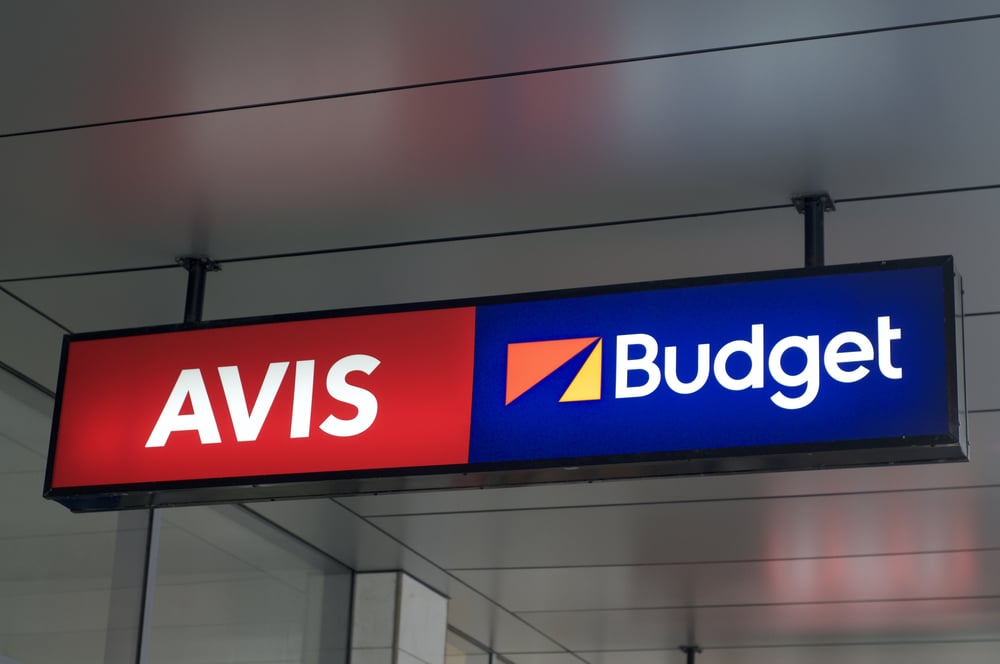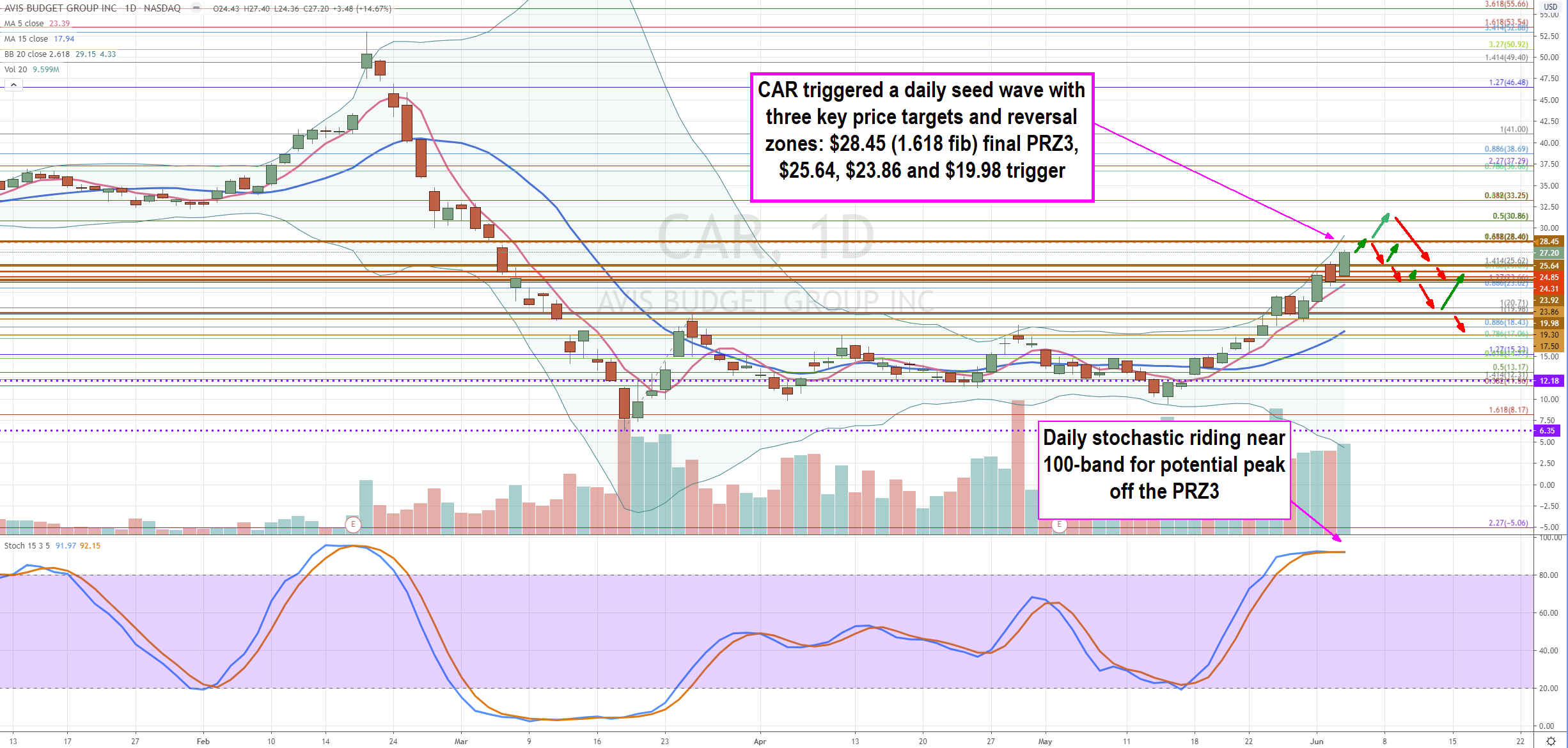
Automobile rental giant
Avis Budget NYSE: CAR shares reached multi-year highs of $52.98 on Feb. 20, 2020, in reaction to its Q4 2020 earnings beat by $0.23 on record $2.2 billion revenues, up 6% year-over-year (YoY). Unfortunately, the coronavirus black swan blindsided the equity markets that same day as the
S&P 500 index NYSEARCA: SPY began its five-week slide falling (-34%) off its all-time highs set a record for the fastest drop into a bear market in history. Avis shares proceeded to collapse to a low of $6.35, falling (-85%) off the highs along with its main rival
Hertz Global NYSE: HTZ falling (-85%) to a low of $3.18 on Mar. 18
th, as markets commenced its recovery. Fast forward to June 2020, the SPY has recovered nearly 100-points off its lows as Nasdaq 100 near new all-time highs. Avis claims the “sole survivor” narrative in the car rental industry as competitor Hertz filed voluntary Chapter 11 bankruptcy on May 22, 2020. HTZ shares fell under $0.85-per share while CAR shares recover into the $27s. The narrative assumes Avis Budget is out of the woods, while Hertz is out of business. However, this is not the case. Markets may be overestimating the safety of Avis’s financial situation as share prices overshoot to the upside.
Last Man Standing Narrative is Wrong
The bankruptcy of Hertz draws a misguided conclusion that Avis will benefit by taking Hertz’s customers to grow its own user base. Hertz continues to operate and the fear of losing hard-earned rewards points can trigger a surge in traffic. While Hertz is the publicly traded competitor to Avid, the largest player in the game is privately-owned Enterprise Holdings, which owns Enterprise Rent-A-Car, National and Alamo brands. The combination of Avis, Hertz, and Enterprise comprises 95% of the global automobile rental industry.
Hertz Still Operating During Chapter 11 Bankruptcy
Hertz filed Chapter 11 Reorganization in the U.S. Bankruptcy Court for District of Delaware on May 22, 2020. The bankruptcy doesn’t apply to principal international operating regions including Europe, Australia and New Zealand or franchised locations. The assumption that all Hertz car rental places have closed down is completely wrong. All brands including Hertz, Dollar, Thrifty, Firefly, Hertz Care Sales, and Donlen subsidiaries are open and still operating. Additionally, Hertz will maintain its loyalty and rewards programs. This alone should cause a spike in traffic as loyalty program members will likely try to spend as many points as possible for fear of losing them. The Company has $1 billion in cash and will continue to operate worldwide throughout the reorganization.
The Pandemic Perfect Storm
While Avis has illustrated superior fleet and cash management, all rental car companies share a similar operating model. They purchase fleets of automobiles to rent out and then sell them through various distribution channels including back to the manufacturers under lease agreements. This takes a tremendous amount of debt financing. Hertz has $20 billion in long-term debt. Avid has $18 billion in long-term debt. By cycling through cars, the rental company maintains relatively low maintenance costs and high-quality vehicles. This cycle breaks down if demand collapses causing revenues to take a steep decline, supply depreciation, used car values fall and or the Company can’t meet asset-backed-securities (ABS) lender covenants. The Covid-19 pandemic triggered a perfect storm as all four conditions triggered simultaneously under stay-in-shelter isolation mandates were initiated to prevent the spread. Both Hertz and Avis share a monthly cash burn rate of (-$200 million) during the pandemic. Hertz has $1 billion in cash and Avis has $1.6 billion in cash and a $750 million revolver. So why did Hertz file Chapter 11 but Avis didn’t?
Can Avis Meet June 30th Covenants?
Hertz missed a May 4th payment of $500 million to its creditors but was able to negotiate an extension until May 22, 2020. The $500 million was to serve as collateral on the declining value of its fleet inventory, which needs to maintain $1.5 billion (including cash) under the ABS covenants. This was the cause for the chapter 11 filing to renegotiate terms with its Tier 1 ABS lenders. Creditors can seek recoup some of their investment through the liquidation of Hertz inventory, which would disrupt operations. If Hertz liquidates inventory, that would trigger a supply surge in the used car market which could spark a deeper downdraft in used car values. This is important because Avis must also honor the covenants of its first tier ABS lenders. Apparently, Avis breached its covenant (like Hertz), but ABS lenders extended the deadline to June 30th, 2020. Hypothetically, if Avis’s ABS lenders also seek $1.5 billion payment to meet covenant requirements, that leaves roughly $850 million in cash with a (-$200 million) monthly burn rate providing two-quarters at best for the restart recovery to make a material impact. All eyes will be on Avis heading into the June 30thdeadline.

Price Trajectory Levels
Using the rifle charts on the wider weekly and daily time frames to lay out the playing field is suitable for swing traders and investors. CAR has made an impressive recovery since triggering the daily market structure low (MSL) above $12.82 but forming a ceiling at $19.98 Fibonacci (fib) level. CAR also formed a rare bullish seed wave pattern that forecasts three upside price target and potential reversal zone (PRZ) using the 1.27, 1.414 and 1.618 fib extensions. Usually, the PRZ 3 (1.618 fib) tends to form the “top” of the trend move. Investors may look to trim down positions at the PRZ 3 area and nimble traders may look to play the reversions off that area. The daily seed wave PRZ reversion levels are $28.45 (1.618 and monthly 15-period moving average), $25.64, $23.86 and the $19.98 trigger. Nimble traders can play reversions off these levels while investors should be aware of these support levels for opportunities to trim ahead. Investors may consider unwinding positions ahead of or implementing trail stops below the trajectory levels and monitor price action heading into June 30th deadline.
Before you make your next trade, you'll want to hear this.
MarketBeat keeps track of Wall Street's top-rated and best performing research analysts and the stocks they recommend to their clients on a daily basis.
Our team has identified the five stocks that top analysts are quietly whispering to their clients to buy now before the broader market catches on... and none of the big name stocks were on the list.
They believe these five stocks are the five best companies for investors to buy now...
See The Five Stocks Here
Click the link below and we'll send you MarketBeat's guide to investing in electric vehicle technologies (EV) and which EV stocks show the most promise.
Get This Free Report